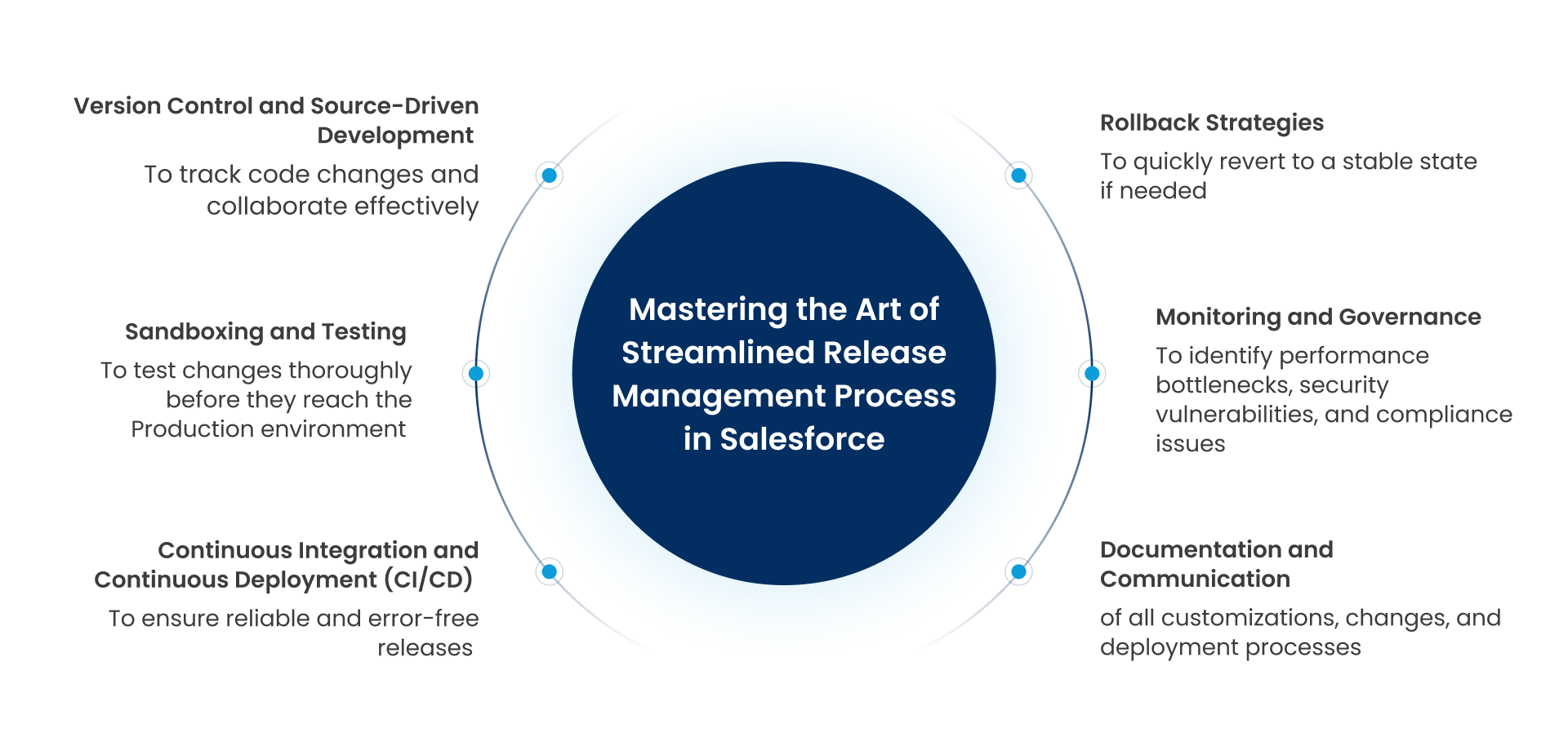Salesforce is a powerful platform that offers a wide range of features and capabilities for businesses. However, with frequent releases and constant updates, managing the release process can become a daunting task. In this article, we will explore the best practices for mastering the art of a streamlined release management process in Salesforce. By following these guidelines, you can ensure smooth deployments, minimize errors, and maximize the efficiency of your Salesforce implementations.
Understanding Salesforce Releases
Salesforce follows a three-times-a-year release cycle, introducing new features, enhancements, and bug fixes. These releases impact all Salesforce instances, including Sandboxes, Developer, and Production environments. To stay informed about the changes and updates in each release, Salesforce provides a Release Notes document. It is essential to review these release notes thoroughly to understand the impact of the changes and plan accordingly.
Types of Salesforce Environments
Salesforce offers various environments that serve different purposes. Developers typically work in Developer Environments to build and test new features. These environments allow developers to experiment and iterate without affecting the production environment. Sandboxes, on the other hand, mirror your Production environment and are used for comprehensive testing. They provide a safe space to test new functionalities, integrations, and configurations before deploying to Production. Production is the live environment where your users interact with the system. It is essential to have a clear understanding of the different environments and their roles in the release management process.
Salesforce Release Management Best Practices
Release management best practices can be broken down into several key tenets, each critical to achieving optimal results:

1. Version Control and Source-Driven Development
Implementing version control systems, such as Git, is crucial for tracking code changes and collaborating effectively. By using version control, you can keep track of all the changes made to your Salesforce codebase, including configuration changes and Apex code modifications. It also allows you to roll back to a previous version if needed. Additionally, adopting source-driven development practices, like Salesforce DX, can help manage your source code effectively. Salesforce DX provides a set of tools and features that streamline the development and deployment process, improving collaboration among developers.
2. Sandboxing and Testing
Sandboxing plays a vital role in the release management process in Salesforce. It allows you to test changes thoroughly before they reach the Production environment. Salesforce offers different types of Sandboxes, including Full, Partial, and Developer Sandboxes, each serving different purposes. Full Sandboxes are exact replicas of your Production environment and are suitable for comprehensive testing. Partial Sandboxes contain a subset of your Production data and are ideal for testing specific use cases. Developer Sandboxes are lightweight environments used primarily for individual development and testing. Implementing comprehensive testing strategies, including unit tests, integration tests, and user acceptance testing, is crucial to ensure the stability and functionality of your Salesforce implementation.
3. Continuous Integration and Continuous Deployment (CI/CD)
Implementing a CI/CD pipeline is a game-changer in the release management process. CI/CD pipelines automate the deployment process, reducing manual errors and speeding up releases. By integrating tools like Jenkins, Travis CI, and Salesforce DX, you can achieve a streamlined and efficient release management workflow. These tools enable automated testing, code quality checks, and deployment automation, ensuring that your releases are reliable and error-free.
4. Rollback Strategies
Even with careful planning and testing, deployments may sometimes cause unforeseen issues in the Production environment. It is crucial to establish rollback plans and strategies to quickly revert to a stable state if needed. Having a well-defined rollback strategy minimizes the impact of unexpected issues and ensures a smooth transition back to a working state. Regularly reviewing and updating your rollback plans based on lessons learned from previous deployments will help you mitigate risks effectively.
5. Monitoring and Governance
Monitoring your Salesforce environment is essential to identify performance bottlenecks, security vulnerabilities, and compliance issues. Implementing governance policies to control access and maintain data integrity is equally important. By regularly monitoring your Salesforce instance, you can proactively address any issues and ensure the stability and security of your system. Additionally, having a robust governance framework in place helps maintain a consistent and controlled release management process.
6. Documentation and Communication
Thorough documentation is key to streamlining the release management process in Salesforce. Document all customizations, changes, and deployment processes to ensure that the knowledge is shared and easily accessible to the team. This documentation serves as a reference point and helps onboard new team members quickly. Furthermore, effective communication is crucial in the release management process. Communicate changes and scheduled deployments to all stakeholders to ensure transparency and alignment. This ensures that everyone is aware of the upcoming changes and can plan their activities accordingly.
Conclusion
Release management processes mature over time, and it’s essential to start somewhere and iterate. Wrong processes can be corrected, but having no processes can hinder progress. Organizations should observe what isn’t working and make gradual changes, ensuring a smooth transition to more effective Salesforce Release Management practices. Mastering the art of a streamlined release management process in Salesforce requires a combination of best practices, tools, and effective communication. By understanding Salesforce releases, utilizing sandboxing and testing, implementing version control, adopting CI/CD practices, establishing rollback strategies, monitoring and governance, and maintaining thorough documentation and communication, you can ensure smooth and efficient releases.
If you’re seeking professional guidance to optimize your Salesforce journey, get answers from our experts and business leaders at CoreFlex.
CoreFlex Salesforce Team







